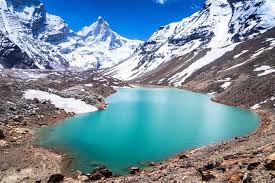ISRO’s recent revelations regarding the expansion of glacial lakes in the Himalayas underscore the urgent need for heightened monitoring and mitigation efforts in the face of climate change-induced risks.
The Indian Space Research Organisation (ISRO) has unveiled alarming findings regarding the expansion of glacial lakes in the Himalayas, shedding light on the impact of climate change on this ecologically sensitive region.
According to ISRO’s satellite monitoring, more than 27% of identified glacial lakes in the Himalayas have significantly expanded since 1984, with 130 of these lakes located in India. The long-term satellite imagery spanning nearly four decades indicates substantial changes in the size and number of these lakes.
Of the 2,431 lakes identified, 676 have notably expanded, with 601 lakes growing more than twice their original size. These expanding lakes pose potential risks, especially considering their locations within the catchments of major Indian Himalayan river basins.


An elevation-based analysis reveals that a significant number of these expanding lakes are situated at higher altitudes, with 314 lakes located in the 4,000-5,000-meter range and 296 lakes above 5,000 meters. ISRO’s data highlights the diverse formation processes of these glacial lakes, categorized into moraine-dammed, ice-dammed, erosion, and other types.
One notable example is the Ghepang Ghat glacial lake in Himachal Pradesh, which witnessed a staggering 178% increase in size between 1989 and 2022, underscoring the rapid pace of expansion.
The consequences of such expansions were tragically demonstrated in October when the bursting of the South Lhonak Lake in Sikkim led to loss of lives and widespread destruction. These incidents highlight the urgent need for robust monitoring and mitigation measures to address the risks associated with glacial lake outburst floods (GLOFs).
The findings emphasize the critical role of satellite remote sensing technology in monitoring and studying glacial lakes, given the challenging terrain of the Himalayan region. Understanding long-term changes in these lakes is vital for assessing glacier retreat rates, evaluating GLOF risks, and comprehending the broader impacts of climate change on the region.
#ISRO #Himalayas #GlacialLakes #ClimateChange #SatelliteMonitoring #GLOFs #EnvironmentalImpact



